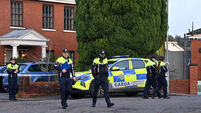It’s terrible how complacent we can become about Irish tourist attractions

If I handed you a list of the top 10 things to do in Ireland before you die, how many do you reckon you could tick off?
Confession — I’ve never been to the Giant’s Causeway. Or the Guinness Storehouse. I’ve never seen the wildflower season in the Burren nor taken a boat tour to Skellig Michael. But as of this month, dear reader, I have been to Newgrange, and it only took me 30 years to get there! (Slow progress is still progress, I always say.)
It’s terrible, how complacent we can become about tourist attractions in our own country, putting off a visit for ‘someday soon’, while Americans on tour buses see literally every single thing, place, and person of interest in Ireland within five days.
I enlisted my father as my trusty travel companion — he can be counted on to keep me stocked in bottled water and protein bars — and we set sail for Dublin. He doesn’t like music to be played in the car, and he’s not too fond of podcasts or, er, talking, so it was a delightfully silent road trip. (Have you ever realised how loud your thoughts can seem? Because I have.)
By the time we arrived at the visitor centre, I was so starved for conversation that I was reduced to an extensive internal monologue where I imagined what I would say to that mean boy from nursery school who said my hair was too short to play Mary in the Nativity — hold a grudge, me? — but I soon rallied around.
Some background on the site; there are three passage tombs located here, Newgrange, Knowth, and Dowth, and they are collectively known as Brú na Bóinne, as they are situated in the River Boyne valley. They were built by Stone Age farmers approximately 5,000 years ago, but public access is only granted to Newgrange and Knowth.
We began our tour at the Knowth passage tomb, which contains a chamber that is illuminated during the spring and autumn equinoxes, and has a great deal many more kerbstones than Newgrange, all of which are decorated in extraordinary megalithic art, swirls and circles and spirals galore. I say ‘art’, but no one is entirely sure if it’s actually art or an ancient form of language that we simply can’t decipher today.
As with everything else at Brú na Bóinne, we were told that we must make up our own minds about what happened here, and such freedom to insert yourself into the narrative was oddly thrilling.
I did enjoy when the tour guide mentioned that one could visit Tír na nÓg by touching these stones and meditating for hours, but our bus was arriving to pick us up in less than 10 minutes, so unfortunately I didn’t have a chance to test it out. (That would make an excellent tagline for my column: Louise O’Neill is away.)
I was surprised to find that Knowth was my favourite site, but Newgrange is, without a shadow of a doubt, the most popular of the three.
This is due to the famous alignment of the rising sun on the winter solstice with the chamber found inside the passage, and, as it was constructed in 3,200BC, Newgrange is older than both Stonehenge and the Egyptian Pyramids, which is a good balm to our national inferiority complex.
It is notoriously difficult to procure a ticket to see the sun rise here on December 21 (there are only 50 spaces available and over 30,000 people applied last year —and you’re not even guaranteed sunshine), but on the day we were there, the tour guide turned off the lights in the chamber and showed us an approximation of what it would be like to be there for the solstice, a crack of light needling its way into the dark, and a shiver ran up my spine.
Being in that tiny, cramped chamber, surrounded by stones that were assembled more than 5,000 years ago, you can’t help but imagine what the people who created these passage tombs would think if they had been told that in 2019, hundreds of thousands of people from around the world would make a pilgrimage to this same site to inspect their exquisite handiwork.
Would they be awed, as we would assume, by our car, electricity and smartphones? Somehow, I couldn’t help but think that as unknowable and technologically advanced as we might appear to those Stone Age farmers, there is so much about their work that is similarly awe-inspiring and unexplainable to us. How did they manage to lift such enormous stones without the use of horses? What kind of brilliant architects did they have amongst them to build something that would so precisely honour the sunrise on the winter solstice?
The ingenuity and technical skill displayed at Newgrange and Knowth were breathtaking, especially when you consider the lack of tools and equipment that such an endeavour would necessitate if undertaken today.
My father and I left Brú na Bóinne that day exchanging increasingly wild theories about the people who lived here — Dad didn’t seem too impressed with my hypothesis that the Tuatha Dé Danann were, in fact, an alien people come from the skies and they had given the farmers a helping hand — but we both felt we had seen something a little magical.
Louise says
What Red Was by Rosie Price.
When Kate Qualie meets Max Rippon - and then his wealthy, artistic family - a life-changing friendship begins.
This is an incredibly nuanced exploration of sexual violence and, in my opinion, heralds the arrival of a major literary talent.
Dating Around on Netflix.
This slick, expensive reality show is easy to watch and it's beautifully shot - New York has never looked so appealing - but it also has a lot of interesting things to say about the dating scene. (My favourites are the Gurki and Leonard episodes.)













